北の生活文化(Popular performing arts handed down from)
Popular performing arts handed down from
settlers' original villages: Arauma odori and Shishimai |
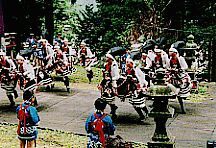 |
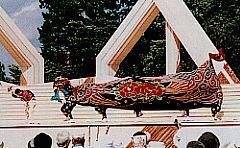 |
| 116. Shirafu Arauma odori in Fukushima town |
117. Shishi Kagura in Shintotsukawa |
Among the forms of performing arts which were handed down by the ordinary people through the interactions between people in different regions are the Arauma odori, the untamed horse dance, and the Shishimai or lion dance.
The Arauma odori could be seen from early times in Shirakami and Shirafu in Fukushima town. Performing arts dedicated to the Star Festival (Tanabata Matsuri) which are still conducted today in Fukushima town include the Arauma odori, Bofuri (a dance employing a long bar), the Yase Yase odori (a dance to celebrate a battle victory) and Kinefurimai in which a dancer with a white wig depicting the Ainu people expresses their will to surrender. These components are quite simlar to those of the Haneto in the Nebuta Festibal in Aomori.
As for the Shishimai dance which is referred to as Etchujishi or Sanukijishi, a traditional style of dancing was brought to the settlements from the immigrants' original villages. The Shishimai dance brought by immigrants from Toyama prefecture has been widely disseminated in the festivals in the Kamikawa area. Mukadejishi, which is traditionally performed by many players in areas west of Mt. kurehayama and Futarijishi, performed by two players in areas east of Mt. kurehayama, have been handed down to people whose ancestors came from those areas. Affiliations between the original villages and their counterparts in Hokkaido has recently boosted the introduction of classical performing arts into Hokkaido as seen in the Kirinshishimai dance in Kushiro (phote on No.84) and Kokiriko in Haboro. |
| Contemporary festivals of snow and ice |
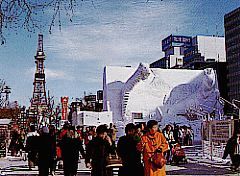 |
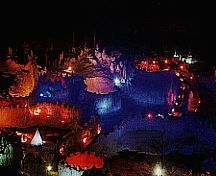 |
| 118. Sapporo Snow Festival |
119. Sounkyo Ice Festival in Kamikawa |
So that they can enjoy the winter months, increasing numbers of festivals are being held in Hokkaido for people who otherwise might become housebound. The Sapporo Snow Festival, which has developed into the largest winter pageant, has its origins in six 3-5 meter high snow statues made in 1950 by junior high school and high school students who were inspired by small statues which were made by pupils of the local elemetary school in Otaru. The Japanese Self Defense Forces joined the festival and began building the gigantic statues in 1955. The festival began to attract keen attention from the rest of the world beginning in 1972 when the Sapporo Winter Olympic Games were hosted. The festivals is held at the three Odori, Makomanai and Susukino sites for 7days in early February and attracted 2.344 million tourists who visited the sites to view 326 statues in 2001.
Abashiri Okhotsk Drift Ice Festival is the largest event along the Okhotsk sea coast. The festival is held in February when the drift ice reaches the coast and features many programs including a display of large snow statues and illuminated ice carvings. In addition , there is a festival of traditional art called "Fire Festival of Orochon" in which music and dance are performed. The "Sounkyo Ice Festival" displays formative arts of ice sculptures along the banks of the Ishikari River, and the "Chitose Lake Shikotsu Ice Festival" is held for two months. Participants create groups of ice statues which are made by spraying water from the lake. February is festival month throughout Hokkaido. |
| Festivities developed in the Showa Era |
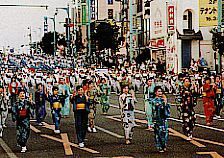 |
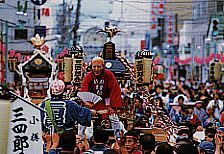 |
| 120. Hakodate Port Festival |
121. Otaru Ushio Festival |
While festivities held in spring and autumn are closely related to ceremonies to ensure a good harvest, ordinary people "blow off steam " in summer festivals some of which started in the Showa Era in the 20th century.
Hakodate has experienced large-scale fires several times in its history and a fire which broke out in 1934 had more than 2000 victims. The Hakodate Port Festival started in 1935 shortly after the outbreak of this fire in an attempt to encourage people to prepare for the restoration of the city. The festival is held during the period from the first till the seventh of August every year. The Dance Parade of 10,000 People was included in the festival program in 1960 in a bid to invite a multitude of participant dancers. The festival successfully grew to be literally the largest pageant in the city in 1986 when the number of dancers reached over 10,000.
The Otaru Ushio Festival which began in 1967 is held annually on Friday, Saturday and Sunday of the last week of July. The festival originally began with the ritual of omizutori until 1994 in which men, known as "Ushio Otoko" sccoped up water from the sea off the coast of Shioya. Although rituals such as these are no longer conducted today, the festival still attracts many young people when a display of 2,500 fireworks is held at the harbor area of Otaru to conclude the festival. The Ushio Nerikomi has been another popular event since the beginning of the festival. It is also known as the "Awa Dance Festival of the North" where participants continue to dance along the streets all day long for some 8 hours. |
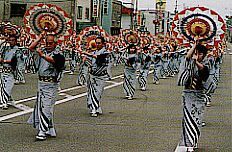 |
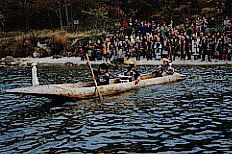 |
| 122. Fukagawa Furusato (Home Town) Festival |
123. Marimo (Aegagropilae) Festival at lake Akan |
In order to contribute to regional revitalization, festivals have been newly launched recently in many municipalities. One of the most popular festivals of this sort is the Hobetsu Rafting Festival which is held annually in Hobetsu at the end of July and which features the Hokkaido Human Raft Race. A boatman runs over the backs and shoulders of fourteen people who line up in the river side by side, taking the place of logs. They move forward making a human raft over and over again until they complete a distance of 150 meters, competing to be the fastest and first to reach the finish line in this race. The spectators greatly enjoy watching the race and applaud loudly each time the participants fall into the water or when a boatman has to stop until the raft is formed again. The spectators also feel they are an integral part of the festival.
Fukagawa has been hosting the Fukagawa Furusato (Home Town) Festival at the end of July with its core program including the Shan Shan Kasa Odori (Umbrella Dance) since 1982. The festival was designed to provide an opportunity for people who had left the town to return at a certain time every year and feel unified with one another emotionally by sharing some moments of excitement at the event. This festival gives them a feeling of pride in their home community of Fukagawa.
The Marimo (Aegagropilae) Festival is an annual event held at Akan in the middle of October which began as part of early conservation initiatives to protect Aegagropilae in 1950. The festival has grown into the most traditional event at lake Akan. The Ainu religious rites connected with receiving and sending off the marimo constitute the major component of the festivities and they are solemnly conducted observing traditionally defined procedures. A visionary atmosphere is created during this three-day festival. |
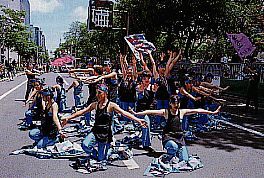 |
| 124. Yosakoi Soran Festival in Sapporo |
Having grown into the largest pageant after the Sapporo Snow Festival, the Yosakoi Soran Festival enlivens and gives color to Sapporo and Hokkaido in early summer. Students of Hokkaido University who saw the Yosakoi Festival in Kochi prefecture began to recruit university students in Hokkaido to hold a similar festival in Sapporo in 1992. An executive committee was organized by students in the following year and adopted the slogan " The whole city is our stage." The first festival was held at Odori Park with some 1,000 dancers in ten teams. The festival is held annually in early June with a large number of dancers spanning all age groups coming to Sapporo from the rest of Hokkaido and Japan.
The participants can freely determine performing style and music composition as long as they follow the rules that dancers hold a clapper in one hand and that the basic elements of the Hokkaido folksong Soranbushi are incorporated in the music. Audiences are overwhelmed to see the lines of dancers in elaborate costumes led by a truck loaded with audio equipment marching and dancing in the streets of Sapporo accompanied by powerful and stirring music. The festival has developed to the extent that 375 teams totalling 38,000 dancers joined the events in 2000 attracting visitors to Sapporo who outnumbered the population of the city.
The festival is unprecedented in that dances are arranged freely and performed in the streets and at a public square. Also, the festival has branched out as small-scale Yosakoi Matsuri in various locations in Hokkaido and further to other areas of the country. The portable Yosakoi Shrine has been established where dancers can visit to pray for success. |

